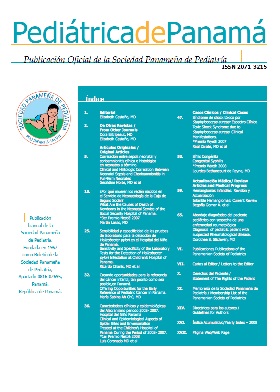Prevalence and patterns of acquired resistance to antiretrovirals in children under 18 years of age
[Prevalence and patterns of acquired resistance to antiretrovirals in children under 18 years of age]2021-06-28
Downloads
Keywords:
VIH, pediatría, antirretrovirales, resistenciaKeywords:
HIV, pediatrics, antiretroviral, resistanceAbstract
Introducción: La resistencia a antirretrovirales compromete la efectividad del tratamiento de pacientes con infección por VIH, llevando a falla virológica e inmunológica, deterioro clínico y comprometiendo tratamientos futuros. Los niños y adolescentes tienen mayor riesgo de desarrollo de resistencia asociados a terapias prolongadas, mala adherencia y limitadas opciones terapéuticas. Se desconoce la prevalencia y patrones de resistencia adquirida en población pediátrica panameña.
Objetivos: Conocer la prevalencia y describir los patrones de resistencia adquirida en población pediátrica infectada con falla virológica en el período 2009-2019
Material y Método: Estudio descriptivo. Se incluyeron sujetos menores de 18 años de edad, con al menos un año de tratamiento, en falla virológica y que contaban con una prueba de genotipaje. Se realizó revisión de los expedientes clínicos para la obtención de los datos. Se describen las características demográficas, historial de tratamiento, resistencia a familias de antirretrovirales y mutaciones específicas
Resultados y conclusiones: 13 pacientes fueron incluidos en el estudio de un total de 72 pacientes con infección de VIH atendidos en el período de estudio, para una prevalencia de resistencia del 18% de sujetos en terapia con resistencia. Se encontró 92% de resistencia a Inhibidores de la transcriptasa reversa análogo de nucleósidos, 61.5% a inhibidores de la transcriptasa reversa no análogos de nucleósidos y 23% de resistencia a Inhibidores de proteasa, las mutaciones M184V y K103N fueron las más frecuentes. Se requiere mantener la vigilancia de resistencia en niños con el fin de ajustar las recomendaciones de tratamiento.
Abstract
Introduction: Antiretroviral resistance compromises the effectiveness of the treatment of patients with HIV infection, leading to virological and immunological failure, clinical deterioration and compromising future treatments. Children and adolescents are at increased risk of developing resistance associated with prolonged therapies, poor adherence, and limited therapeutic options. The prevalence and patterns of acquired resistance in the Panamanian pediatric population are unknown.
Metodology Descriptive study. Subjects under 18 years of age, with at least one year of treatment, in virological failure and who had a genotyping test were included. A review of the clinical records was carried out to obtain the data. Demographic characteristics, treatment history, and at the time of genotyping, resistance to antiretroviral families and specific mutations are described.
Conclusions: 13 patients were included in the study of a total of 72 patients with HIV infection attended in the study period, for a prevalence of 18% of subjects on antiretroviral therapy. It was found 92% resistance to nucleoside reverse transcriptase inhibitor, 61.5% to non- nucleoside reverse transcriptase inhibitor and 23% resistance to protease inhibitor. The M184V and K103N mutation were the most frequent. Surveillance of ARV resistance in children is required to adjust treatment recommendations.
License
Copyright (c) 2021 Infomedic InternationalDerechos autoriales y de reproducibilidad. La Revista Pediátrica de Panamá es un ente académico, sin fines de lucro, que forma parte de la Sociedad Panameña de Pediatría. Sus publicaciones son de tipo ACCESO GRATUITO y PERMANENTE de su contenido para uso individual y académico, sin restricción. Los derechos autoriales de cada artículo son retenidos por sus autores. Al Publicar en la Revista, el autor otorga Licencia permanente, exclusiva, e irrevocable a la Sociedad para la edición del manuscrito, y otorga a la empresa editorial, Infomedic International Licencia de uso de distribución, indexación y comercial exclusiva, permanente e irrevocable de su contenido y para la generación de productos y servicios derivados del mismo.






